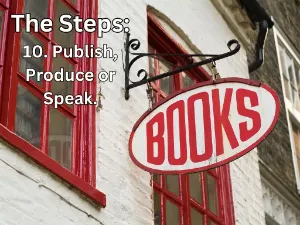Company booklet & brochure writing services. Capitalize on a long-lasting marketing device.
By- Michael McKown & Robert Grock
Good advice: Don’t walk into a sales meeting or a convention without a booklet or brochure that succinctly and effectively describes your company, how it can benefit your customers, and shows how it differs from your competition. A brochure picked up at a table is a sales message with longevity. It gets looked at by prospective clients and passed around.

For purposes of clarity: A booklet is bound and consists of individual pages. A brochure is folded. A booklet can go into far more detail than a brochure. A brochure will contain far less information, but it will be cheaper to produce. In our experience, a booklet is far more likely to be retained by prospective customers than a brochure.
Ghostwriters Central has writers on staff who can help develop compelling text in collaboration with you. All you need to do is click on Contact.
Ten things that should be included in a company booklet or brochure
When creating a sales booklet for a company, it’s important to include relevant information that effectively communicates the company’s value proposition and encourages potential customers to take action. Here are some key elements to consider including:
Cover and Branding: The booklet should have an appealing cover design that reflects the company’s brand identity and creates a positive first impression. Incorporate the company logo, tagline, and visually engaging elements that capture attention.
Introduction and Company Overview: Start with a compelling introduction that grabs the reader’s attention. Provide a concise overview of the company, highlighting its history, mission, and unique selling points. Focus on the benefits customers can expect from working with the company.
Products or Services: Describe the company’s offerings in detail. Highlight the key features, benefits, and advantages of each product or service. Use clear and concise language, accompanied by compelling visuals, such as 
Testimonials and Case Studies: Include testimonials or success stories from satisfied customers. These can add credibility and demonstrate the company’s track record of delivering value. Real-life examples and case studies showcasing the company’s expertise and results can be highly persuasive.
Pricing and Packages: If applicable, provide pricing information or different packages available. Clearly outline what customers can expect at each price point and the value they will receive. Use pricing tables or charts to make it easy to understand the options.
Competitive Advantage: Highlight what sets the company apart from competitors. Identify the unique features, innovations, or advantages that make the company the best choice for customers. Differentiate the company based on quality, reliability, customer service, or any other key factors.
Customer Support and After-Sales Service: Emphasize the company’s commitment to customer satisfaction. Explain the support channels available, such as helplines, online resources, or warranties. Showcase any additional services offered, such as installation, training, or ongoing maintenance.
Contact Information and Call-to-Action: Provide clear contact information, including the company’s address, phone number, email, and website. Encourage readers to take action by including a strong call-to-action, such as “Contact Us Today,” “Request a Demo,” or “Get a Free Quote.” Make it easy for potential customers to connect with the company.
Visuals and Design: Use high-quality visuals throughout the booklet to make it visually appealing and engaging. Include images, charts, graphs, and illustrations that support the content and make it easier to understand. Ensure the design is consistent with the company’s branding guidelines.

Remember to tailor the content and design to your target audience, focusing on their needs and problems that require solutions your company can provide. Every business owner or corporate executive has problems to solve. If you offer the solution, we recommend you put it up front. Why? It gets you noticed and remembered!
A well-crafted sales booklet should effectively communicate the company’s value proposition, build trust, and motivate potential customers to take the desired action, whether it’s making a purchase, scheduling a meeting, or reaching out for more information. For example, one competitive advantage for Ghostwriters Central is: We actually answer the phone. In our business, that’s uncommon. And in many cases, there is no phone number to call. To discuss your sales brochure or booklet, click on Contact.











